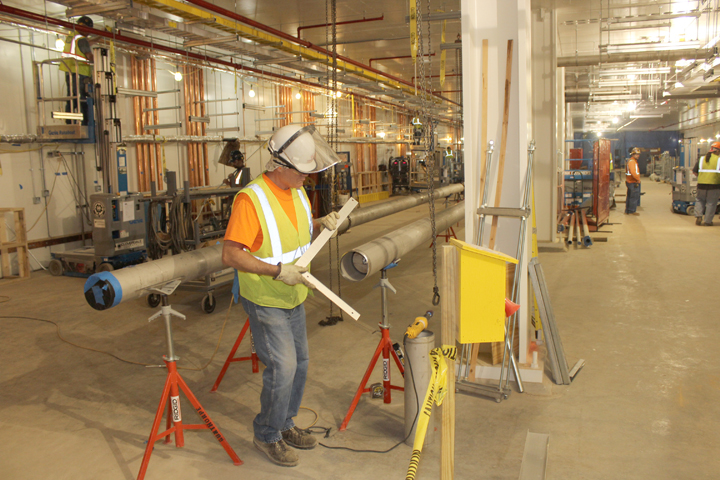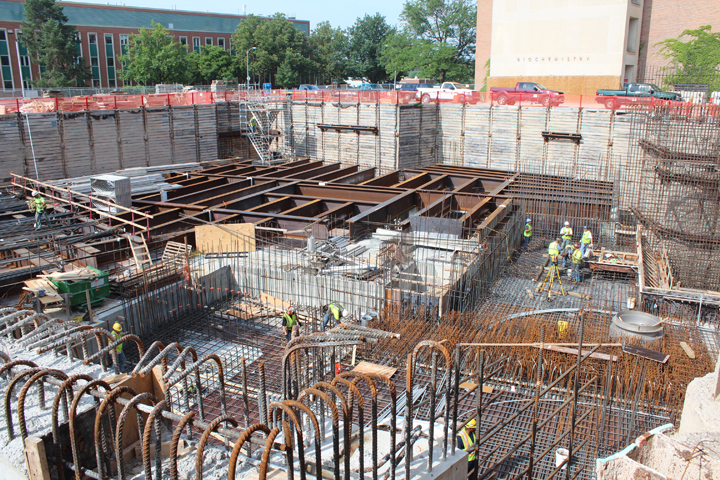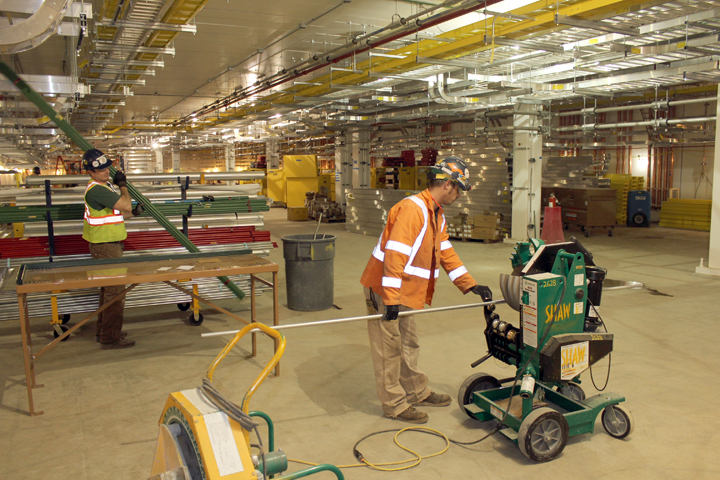High-tech FRIB project calls for heavy-duty construction
Date Posted: July 24 2015

EAST LANSING - The Facility for Rare Isotope Beams (FRIB) currently under construction on the campus of Michigan State University is sure to make the school even more of a beacon for nuclear physicists from around the world.
The FRIB will be the most powerful rare isotope accelerator in the world, allowing scientists to make discoveries about isotopes' properties, nuclear astrophysics, fundamental interactions, and applications for society, including medicine, homeland security and industry. But first, the FRIB needs a crib, and that's where construction manager Barton Malow, their subcontractors and the building trades have stepped in.
"Construction has gone really well, we're exceptionally pleased with the quality of work we're seeing," said the FRIB's Brad Bull, Michigan State University's conventional facilities and infrastructure division director. "One of the things that helped us win the project was the presence of the quality workforce in the area, and they have come through. The building trades have been very helpful, their safety record is exceptional, and I think they're happy to be here. From an owner's perspective, it's been very, very easy to work with the trades, we haven't had to worry about them."
MSU won the national competition to design and establish the $730 million FRIB in 2008. Project excavation adjacent to the university's existing National Superconducting Cyclotron Laboratory at Bogue St. and Shaw Lane began in March 2014. Since then, one of the highlights of the construction process was the marathon, 25-hour concrete pour that began March 3, 2015 which saw the placement of 3,563 cubic yards of concrete, poured from 350 trucks to build the project's linear accelerator tunnel.
The experiments that will go on in the tunnel when the FRIB is expected to go online in 2022 are the focus of the entire facility. The 35-foot-deep tunnel is 570 feet long, 70 feet wide and 13 feet high. The tunnel's reinforced concrete walls, ceilings and floors are up to four-and-a-half feet thick, and areas that will shield workers in the tunnel will be up to 16 feet thick.
Setting up concrete reinforcing rod at the site earlier this month was Tony Abel of Iron Workers Local 25, working for Quality Re-Steel. Some of the re-bar sections were four times thicker than would be found on a typical floor slab in say, an office building. "I've been in the trade 24 years, and this is as big as I've seen," he said. The entire concrete tunnel will be lined with copper mesh to quell electromagnetic interference. Then the tunnel will be buried under 21 feet of soil.
"Obviously, it's not a typical structure," said Todd Elkin, Michigan State University integration engineer for the FRIB. "Its mass, the girth of the building, the walls, roof, floor, steel members, and the amount of power coming in to power and cool the operations - it's just so heavy, so unique."
What will go on under there? Follow along, you will be tested. According to MSU, ion sources first boil a sample element, knock off electrons, and push the ionized atoms around with electric and magnetic fields to create beams that are injected into the linear accelerator. The 400-kilowatt Superconducting RF Linear Accelerator will then drive these particles down a track at ever-increasing speeds, providing the highest intensity beams at half the speed of light. At the Rare Isotope Production and Isotope Harvesting area next door, those beams strike a target and when their nuclei collide, rare isotopes are produced. In the facility's Experimental Area, tests performed with fast, stopped and re-accelerated beams can measure the unique properties of rare isotopes, giving scientists "unprecedented understanding" of the matter, according to MSU.
The FRIB's operations, which have a 25-megawatt capacity, will be run by "an extension cord," Elkin said, to the T.B. Simon Power Plant on campus. Not only will the FRIB's operations draw a lot of power, the facility's mechanical works will also have unique, beefed-up cooling needs, such as systems to handle liquid helium and liquid nitrogen to provide super-cooling to magnets and power supplies.
Above the tunnel, construction will include a service structure for the linear accelerator, and three other buildings, totaling 220,160 square feet. "Above ground, at least, the construction is fairly straightforward," said Elkin. "But in the tunnel we're also building one of the most sophisticated machines in the world. Overall, I think the biggest challenge we have is mending the project's scientific needs with the construction. There's a tremendous amount of coordination necessary to make sure that everything is in place for the scientific equipment."
The FRIB will cement Michigan State University's status as a top school for physicists - U.S. News and World Report has ranked the university's nuclear physics graduate program No. 1 in the nation, and each year about 10 percent of the nation's nuclear science PhD holders are educated at MSU.
"FRIB will be the core of our nation’s research infrastructure, advancing knowledge in areas such as science, medicine and homeland security, as well as providing answers to questions we have even yet to conceive,” said MSU President Lou Anna K. Simon. “This facility also will be a training ground for the world’s next generation of nuclear physicists and attract scientists and engineers from all corners of the earth, securing MSU’s position as the driver in the knowledge economy.
The Facility for Rare Isotope Beams supports the mission of the Office of Nuclear Physics in the U.S. Department of Energy Office of Science. FRIB is funded by DOE-SC and operated by Michigan State University.
At the groundbreaking for the FRIB, U.S. Sen. Debbie Stabenow, who pushed hard for federal funding for the project, said FRIB construction "is an historic milestone for MSU and our entire state. It create thousands of new jobs and reinforce MSU's and Michigan's role as a global leader in cutting-edge research that will lead to important discoveries in medicine and other scientific fields."
 THE ROOF of the Linear Accelerator Tunnel at the Facility for Rare Isotope Beams (FRIB) at Michigan State University will be reinforced with some of the thickest re-bar (foreground) and heaviest wide-flange structural steel sections (background) that the steel industry makes.
THE ROOF of the Linear Accelerator Tunnel at the Facility for Rare Isotope Beams (FRIB) at Michigan State University will be reinforced with some of the thickest re-bar (foreground) and heaviest wide-flange structural steel sections (background) that the steel industry makes.
 SQUARING UP HIS WORK on a six-inch stainless pipe at the FRIB is Steve Atherton of Plumbers and Pipe Fitters Local 333. He’s working for Gunthorpe Plumbing.
SQUARING UP HIS WORK on a six-inch stainless pipe at the FRIB is Steve Atherton of Plumbers and Pipe Fitters Local 333. He’s working for Gunthorpe Plumbing.
 WORKING WITH CONDUIT in the linear accelerator tunnel at the FRIB are Matty McPhee and Chris Wegener of IBEW Local 665. They’re employed by Shaw Electric.
WORKING WITH CONDUIT in the linear accelerator tunnel at the FRIB are Matty McPhee and Chris Wegener of IBEW Local 665. They’re employed by Shaw Electric.
